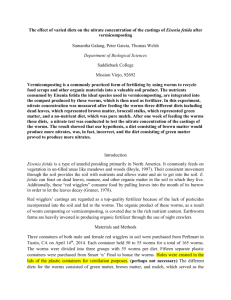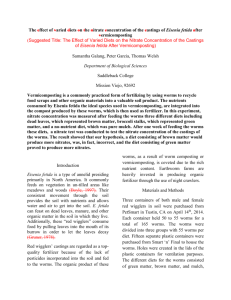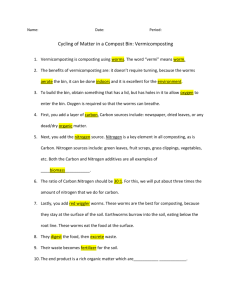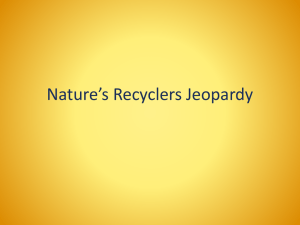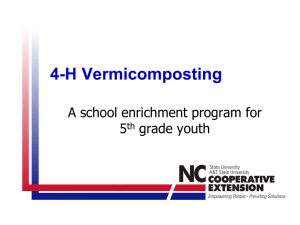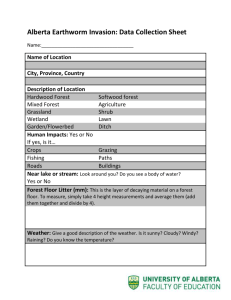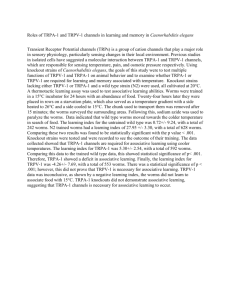Galang Garcia and Welsh1
advertisement
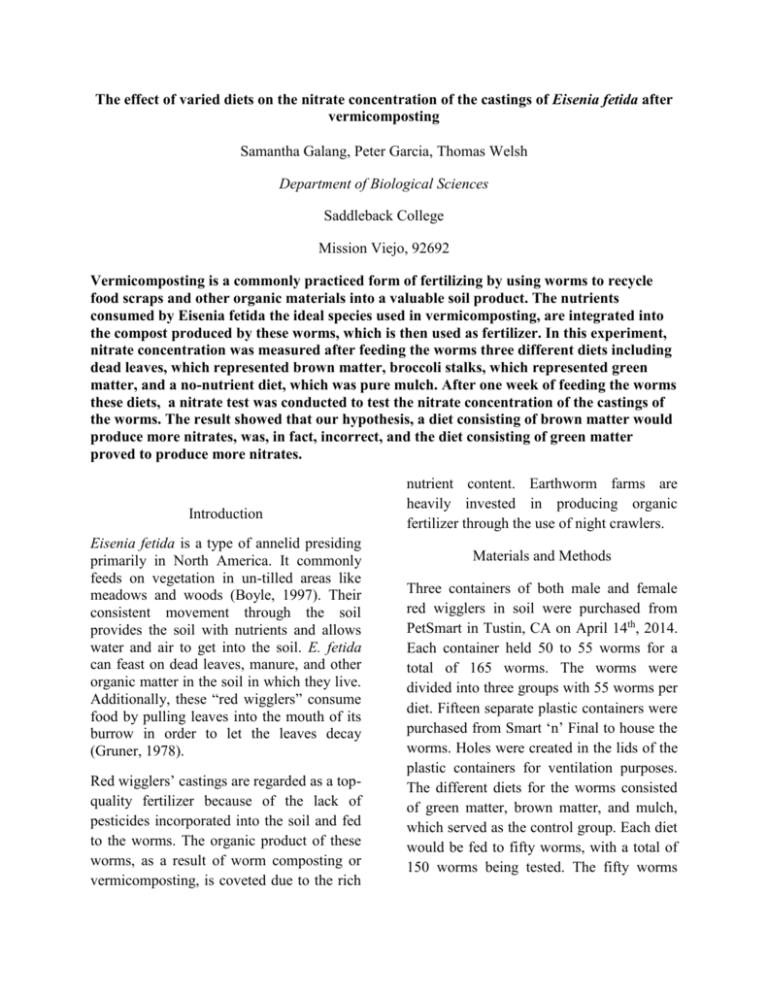
The effect of varied diets on the nitrate concentration of the castings of Eisenia fetida after vermicomposting Samantha Galang, Peter Garcia, Thomas Welsh Department of Biological Sciences Saddleback College Mission Viejo, 92692 Vermicomposting is a commonly practiced form of fertilizing by using worms to recycle food scraps and other organic materials into a valuable soil product. The nutrients consumed by Eisenia fetida the ideal species used in vermicomposting, are integrated into the compost produced by these worms, which is then used as fertilizer. In this experiment, nitrate concentration was measured after feeding the worms three different diets including dead leaves, which represented brown matter, broccoli stalks, which represented green matter, and a no-nutrient diet, which was pure mulch. After one week of feeding the worms these diets, a nitrate test was conducted to test the nitrate concentration of the castings of the worms. The result showed that our hypothesis, a diet consisting of brown matter would produce more nitrates, was, in fact, incorrect, and the diet consisting of green matter proved to produce more nitrates. Introduction Eisenia fetida is a type of annelid presiding primarily in North America. It commonly feeds on vegetation in un-tilled areas like meadows and woods (Boyle, 1997). Their consistent movement through the soil provides the soil with nutrients and allows water and air to get into the soil. E. fetida can feast on dead leaves, manure, and other organic matter in the soil in which they live. Additionally, these “red wigglers” consume food by pulling leaves into the mouth of its burrow in order to let the leaves decay (Gruner, 1978). Red wigglers’ castings are regarded as a topquality fertilizer because of the lack of pesticides incorporated into the soil and fed to the worms. The organic product of these worms, as a result of worm composting or vermicomposting, is coveted due to the rich nutrient content. Earthworm farms are heavily invested in producing organic fertilizer through the use of night crawlers. Materials and Methods Three containers of both male and female red wigglers in soil were purchased from PetSmart in Tustin, CA on April 14th, 2014. Each container held 50 to 55 worms for a total of 165 worms. The worms were divided into three groups with 55 worms per diet. Fifteen separate plastic containers were purchased from Smart ‘n’ Final to house the worms. Holes were created in the lids of the plastic containers for ventilation purposes. The different diets for the worms consisted of green matter, brown matter, and mulch, which served as the control group. Each diet would be fed to fifty worms, with a total of 150 worms being tested. The fifty worms were divided into five containers, equaling ten worms per container. In order to produce create the mulch bedding for the worms while they were in the plastic containers, newspaper was shredded into pieces, no more than one inchthick, and dampened with water. The green matter was produced by blending broccoli stalks with water to break up the broccoli into small, moist pieces. The brown matter was produced by crushing dead leaves and, once again, dampening with water for a softer consistency. Approximately 17.30 g of mulch was placed into each of the fifteen containers. A group of ten worms was weighed, and placed into one container of mulch. This served as the first control group (Group C1). Four more groups of ten worms were weighed and placed into containers, which resulted in the remainder of the control groups (Groups C2 to C5). Approximately two to three grams of green matter was placed into five more containers with mulch. These groups were titled Group V1 to V5. Approximately three to four grams of brown matter was placed into another five containers. Once again, the mass of each group of ten worms was obtained before placing them into the containers. A sample of each diet, mulch + green matter, mulch + brown matter, just mulch, were obtained. Once all the containers of worms were prepared, they were left indoors to retain constant temperature. The castings of each group were obtained for each group, and placed into their own centrifuge tubes. For every gram of castings, 5 mL of 1M KCl was dispensed into the centrifuge tube of castings. The tubes were shaken at 100 rpm for ninety minutes, then centrifuged for fifteen minutes at 3200 g. Afterwards, the sample was decanted into a 10 mL test tube. Each sample was then tested for nitrates using the LaMotte’s testing kit. Using the color scale provided by the nitrate test, each sample was interpreted in terms of nitrate concentration (ppm). Results Using the LaMotte’s Nitrate test kit it was shown that the level of nitrates was highest in the green matter, followed by brown matter, and the control held the least amount of nitrates. Diet Control Group Brown Matter Green Matter Tube 1 0 Tube 2 0 Tube 3 0 Tube 4 0 Tube 5 0 1 1 1 2 1 2 2 2 1 1 Table 1. Comparison between three dietary groups in parts per million (ppm). Green matter yielded the most nitrates in the tubes, while the control group yielded the least amount of nitrates. La Motte’s Nitrate test kit was used to make a comparison between the three dietary groups. We had expected that the Eisenia fetida which were fed a diet of brown matter would have castings that were more nitrate rich. We hypothesized this outcome because the habitat of E. fetida generally consists of the decaying vegetation which exists in the upper soil levels (Paradise 2001). The results indicate that the castings from the E. fetida that were fed the green matter had a higher nitrate concentration. We found that the casting in the green matter had a higher average concentration of nitrates than the brown matter castings by 0.4 ppm. E. fetida are commonly used to help break down dead organic organisms in a process referred to as Vermicomposting. The worms help to aerate the substrate and their castings provide a nutrient rich fertilizer of sorts. E. fetida are also known to decrease microbial bacteria populations while possibly increasing the efficiency of microbial resource utilization (Scheu 2002). Vermicomposting is a faster and safer alternative to regular composting, which can reach high temperatures. The fact that E. fetida more efficiently recycles green matter can allow for more efficient composting through the implementation of vermicomposting. Conversely, these findings could be used to try to mitigate nitrate pollution by decreasing the nitrate levels in the soil by removing the green matter from the area. This finding could also be used to artificially boost population activity in microbial bacterial colonies. As a supplement to this experiment it would be interesting to isolate the species of microbial bacteria that E. fetida affects, and test how this species effects the nutrient concentrations found in the soil. Literature Cited Boyle, K. E., Curry, J. P., & Farrell, E. P. (1997). Influence of earthworms on soil properties and grass production in reclaimed cutover peat. Biology and fertility of soils, 25(1), 20-26. Gruner, B., & Zebe, E. (1978). Studies on the anaerobic metabolism of earthworms. Comparative Biochemistry and Physiology Part B: Comparative Biochemistry, 60(4), 441-445. Paradise, C., 2001, A Standardized Soil Ecotoxicological Test Using Red Worms (Eisenia fetida), The American Biology Teacher, v. 63(9), p. 662-668. Scheu, S., Schlitt, N., Tiunov, A., Newington, J., and Jones, T., 2002, Effects of the Presence and Community Composition of Earthworms on MicrobialCommunity Functioning, Oecologia, v. 133(2), p. 254-260 Review Form Department of Biological Sciences Saddleback College, Mission Viejo, CA 92692 Author (s): Samantha Galang, Peter Garcia, Thomas Welsh . Title: The Effect of Varied Diets on the Nitrate Concentration of the Castings of Eisenia fetida After Vermicomposting Summary Summarize the paper succinctly and dispassionately. Do not criticize here, just show that you understood the paper. Vermicomposting is a form of fertilizing utilizing worms because worms are able to recycle food scraps and other organic materials into soil products. Eisenia fetida was used because their castings lack pesticides, making it the ideal species that is used in vermicomposting. Investigators hypothesized that the brown matter diet would yield a higher concentration of nitrates due to the resemblance in the natural habitat of decaying vegetation. Investigators used three different diets to test for nitrate concentrations; dead leaves blended with water, broccoli stalks blended with water, and mulch, each representing brown matter, green matter and a no nutrient diet, respectively. 55 worms were assigned to one of the three diets, but only 50 worms were fed from each group. The 50 worms for each diet type were divided up into 5 different containers, with each container housing 10 worms and their respective diets. Green matter diet consisted of ~17.30 g of mulch and 2-3 g of the green matter blend, the brown matter diet consisted of ~17.30 g of mulch and 3-4 g of the brown matter blend, and the no nutrient diet only consisted of mulch. Castings in each sample were obtained and were analyzed for their nitrate concentrations. Nitrate levels for each sample were tested for using LaMotte’s testing kit. Green matter diets produced higher concentrations of nitrates, which did not support the investigators hypothesis. The results of this study indicate vermicomposting as an efficient composting method, and could be used to decrease nitrate pollution by reducing the amounts of green matter in areas. General Comments Generally explain the paper’s strengths and weaknesses and whether they are serious, or important to our current state of knowledge. Strengths: Materials and methods are easy to follow and easy to comprehend. Investigators also provided a lot of details in the procedure. Overall the paper is organized, easily understood and flows well. Weaknesses: The paper has some minor grammatical and formatting errors. *Overall a good paper! Could expand in certain areas like the introduction and discussion. Technical Criticism Review technical issues, organization and clarity. Provide a table of typographical errors, grammatical errors, and minor textual problems. It's not the reviewer's job to copy Edit the paper, mark the manuscript. This paper was a final version Section Title Abstract Introduction Materials and Methods Results Discussion Other Formatting This paper was a rough draft Issue Capitalize the title, besides prepositions like of, the, etc. Italicize Eisenia fetida. Could be lengthened, introduction is missing information like: Previous studies, previous findings Why are you testing for this? What is the hypothesis? Date formatting: Day, Month, Year Paragraph 2, Sentence 1 is not easy to follow “In order to produce create the mulch … “ Table caption should be above the table with a smaller sized font than the text in the actual journal. Provide the means of nitrate concentrations from each group to show the difference of 0.4 ppm. (I had to calculate it myself to see that brown matter had an average of 1.2 ppm and green matter had an average of 1.6 ppm) No distinguished discussion section, Paper is missing the discussion heading Headings should be bold No columns according to peer review page Single space between names and department information Literature Cited In text citations (Introduction, Discussion) should include all authors involved in the literature Need 6 more references for the minimum of 10 citations. Recommendation This paper should be published as is This paper should be published with revision This paper should not be published
